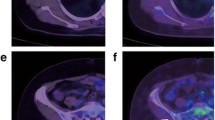Abstract
Objectives
This study investigated the prognostic value of preoperative breast-specific gamma imaging (BSGI) uptake measured by a semi-quantitative method in invasive ductal carcinoma (IDC).
Methods
One hundred and sixty-two women with IDC who underwent preoperative BSGI were retrospectively enrolled. The tumor-to-normal tissue ratio (TNR) was measured on BSGI and correlated with histologic prognostic factors. The prognostic impact of TNR was tested with regard to progression-free survival (PFS) and compared with established prognostic factors.
Results
High TNR was significantly correlated with tumor size >2 cm (p < 0.001), high nuclear grade (p = 0.04), high histologic grade (p = 0.01), axillary node positivity (p = 0.04), ER negativity (p = 0.03), HER2 positivity (p = 0.01), and high MIB-1 index (p = 0.001). Among 162 patients, 14 experienced recurrence during mean follow-up time of 34.7 ± 14.9 months. In Kaplan–Meier survival analyses, high TNR (p < 0.001), high nuclear grade (p = 0.02), high histologic grade (p = 0.007), ER/PR negativity (p = 0.003 and p < 0.001, respectively), HER2 positivity (p = 0.01), triple negativity (p = 0.02), and high MIB-1 index (p = 0.02) showed a significant relationship with poor prognosis. Among them, high TNR was an independent poor prognostic factor in a multivariate regression analysis (p = 0.01).
Conclusions
High BSGI uptake measured by a semi-quantitative method was correlated with diverse poor histologic prognostic factors and was an independent poor prognostic factor in invasive ductal cancer.




Similar content being viewed by others
References
Siegel R, Naishadham D, Jemal A. Cancer statistics, 2012. CA Cancer J Clin. 2012;62:10–29.
Freedman G, Fowble B. Local recurrence after mastectomy or breast-conserving surgery and radiation. Oncology (Williston Park). 2000;14:1561–81.
Pickles MD, Manton DJ, Lowry M, Turnbull LW. Prognostic value of pre-treatment DCE-MRI parameters in predicting disease free and overall survival for breast cancer patients undergoing neoadjuvant chemotherapy. Eur J Radiol. 2009;71:498–505.
Nakajo M, Kajiya Y, Kaneko T, Kaneko Y, Takasaki T, Tani A, et al. FDG PET/CT and diffusion-weighted imaging for breast cancer: prognostic value of maximum standardized uptake values and apparent diffusion coefficient values of the primary lesion. Eur J Nucl Med Mol Imaging. 2010;37:2011–20.
Ueda S, Tsuda H, Asakawa H, Shigekawa T, Fukatsu K, Kondo N, et al. Clinicopathological and prognostic relevance of uptake level using 18F-fluorodeoxyglucose positron emission tomography/computed tomography fusion imaging (18F-FDG PET/CT) in primary breast cancer. Jpn J Clin Oncol. 2008;38:250–8.
Weigert JM, Bertrand ML, Lanzkowsky L, Stern LH, Kieper DA. Results of a multicenter patient registry to determine the clinical impact of breast-specific gamma imaging, a molecular breast imaging technique. Am J Roentgenol. 2012;198:W69–75.
Tadwalkar R, Rapelyea J, Torrente J, Rechtman L, Teal C, Mcswain A, et al. Breast-specific gamma imaging as an adjunct modality for the diagnosis of invasive breast cancer with correlation to tumour size and grade. Br J Radiol. 2012;85:e212–6.
Lumachi F, Ermani M, Marzola M, Zucchetta P, Cecchin D, Basso S, et al. Relationship between prognostic factors of breast cancer and 99mTc-sestamibi uptake in patients who underwent scintimammography: multivariate analysis of causes of false-negative results. The Breast. 2006;15:130–4.
Wang J-H, Scollard DA, Teng S, Reilly RM, Piquette-Miller M. Detection of P-glycoprotein activity in endotoxemic rats by 99mTc-sestamibi imaging. J Nucl Med. 2005;46:1537–45.
Eo JS, Chun IK, Paeng JC, Kang KW, Lee SM, Han W, et al. Imaging sensitivity of dedicated positron emission mammography in relation to tumor size. Breast. 2012;21:66–71.
Papantoniou VJ, Souvatzoglou MA, Valotassiou VJ, Louvrou AN, Ambela C, Koutsikos J, et al. Relationship of cell proliferation (Ki-67) to 99mTc-(V) DMSA uptake in breast cancer. Breast Cancer Res. 2003;6:R56–62.
Cwikla J, Buscombe J, Kolasinska A, Parbhoo S, Thakrar D, Hilson A. Correlation between uptake of Tc-99m sestaMIBI and prognostic factors of breast cancer. Anticancer Res. 1999;19:2299–304.
Cutrone JA, Yospur LS, Khalkhali I, Tolmos J, Devito A, Diggles L, et al. Immunohistologic assessment of technetium-99m-MIBI uptake in benign and malignant breast lesions. J Nucl Med. 1998;39:449–53.
Mulero F, Nicolas F, Roca V, Castellón M, Claver M, de La Cruz P, et al. Usefulness of the quantification of (99M) Tc-MIBI uptake in breast neoplasms in the preoperative assessment of tumor aggressiveness. Rev Esp Med Nucl. 2000;19:263–9.
Utah A. Relation of tumor size, lymph node status, and survival in 24,740 breast cancer cases. Cancer. 1989;63:181–7.
Abe H, Schmidt RA, Kulkarni K, Sennett CA, Mueller JS, Newstead GM. Axillary lymph nodes suspicious for breast cancer metastasis: sampling with US-guided 14-gauge core-needle biopsy—clinical experience in 100 patients. Radiology. 2009;250:41–9.
Slamon DJ, Clark GM, Wong SG, Levin WJ, Ullrich A, McGuire WL. Human breast cancer: correlation of relapse and survival with amplification of the HER-2/neu oncogene. Science. 1987;235:177–82.
Konecny G, Pauletti G, Pegram M, Untch M, Dandekar S, Aguilar Z, et al. Quantitative association between HER-2/neu and steroid hormone receptors in hormone receptor-positive primary breast cancer. J Natl Cancer Inst. 2003;95:142–53.
Bentzon N, Düring M, Rasmussen BB, Mouridsen H, Kroman N. Prognostic effect of estrogen receptor status across age in primary breast cancer. Int J Cancer. 2008;122:1089–94.
de Azambuja E, Cardoso F, de Castro G, Colozza M, Mano MS, Durbecq V, et al. Ki-67 as prognostic marker in early breast cancer: a meta-analysis of published studies involving 12 155 patients. Br J Cancer. 2007;96:1504–13.
Stuart-Harris R, Caldas C, Pinder SE, Pharoah P. Proliferation markers and survival in early breast cancer: a systematic review and meta-analysis of 85 studies in 32,825 patients. Breast. 2008;17:323–34.
Acknowledgments
This research was supported by the Basic Science Research Program and the Bio and Medical Technology Development Program through the National Research Foundation of Korea (NRF) funded by the Ministry of Science, ICT and Future Planning (2012R1A1A1012913 and 2012M3A9B6055379).
Author information
Authors and Affiliations
Corresponding author
Rights and permissions
About this article
Cite this article
Yoon, HJ., Kim, Y., Chang, KT. et al. Prognostic value of semi-quantitative tumor uptake on Tc-99m sestamibi breast-specific gamma imaging in invasive ductal breast cancer. Ann Nucl Med 29, 553–560 (2015). https://doi.org/10.1007/s12149-015-0977-3
Received:
Accepted:
Published:
Issue Date:
DOI: https://doi.org/10.1007/s12149-015-0977-3




